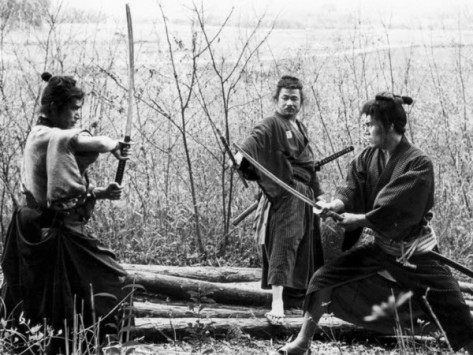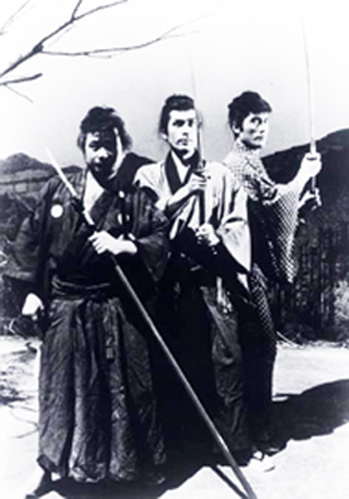
I thought that perhaps “Three Outlaw Samurai” (Sanbiki no samurai, 1964, the movie directorial debut of Gosha Hideo (Sword of the Beast) might be 3/7ths as good as “Seven Samurai.” That hope was about right. It is like “Seven Samurai” in that some ronin decide to help some peasants, though in “3” the peasants are seeking relief from an evil magistrate. (In Chinese history, low-status people have always blamed local officials and believed that “if only the emperor knew” he would rectify the abuses. In Tokugawa times, it was “if only the clan lord knew,” he’d make things right and punish the local official..)
The magistrate has refused to accept a petition from the peasants who are on the verge of starvation. Three of them have kidnapped the magistrate’s daughter (Kuwano Miyuki) and are holding her in a mill. The samurai who happens by, Shiba (the very long-faced Tanba Tetsuro), sits back to watch (like Mifune in “Yojimbo”). He provides advice to the captive and the captors, and (more Nakadai than Mifune) takes a beating to save the peasants, trusting the word of the magistrate given from one samurai to another.
Another wandering samurai, Kikyo (Hira Mikijiro, also long-faced, who would star in “Sword of the Beast”) who has been taken in (and fed by the magistrate) is offended by the magistrate’s violation of his promises. The recruitment of the other one, the earthiest one, Sakura (Nagato Isamu), is too complicated for me to try to summarize. The magistrate’s daughter is also outraged by her father’s perfidy
In tandem (all three never fight together at the same time), the honorable (therefore rebel) samurai cut down many assailants hired by the magistrate to obliterate the problem before the lord passes through. I don’t understand why superior numbers are never used to overwhelm an opponent. The skilled swordsmen cut down assailants in rapid succession, but it seems to have been unthinkable to attack from all sides at once. The good guys (that is, the outlaws, each of whom was reluctant to get involved, especially in opposing local authority) do not escape unscratched, but Shiba, who should be the most winded, still has the ability(/will) to run to the lord’s procession after the most extensive battle.

Although there are extended battles, “Three Outlaw Samurai” doesn’t really seem to be an “action movie.” There are complicated relationships (more even than in “Yojimbo” or “Seven Samurai”) and in the eternal division of plot-driven vs. character-driven, this has to go in the latter category. The mixture of pragmatism, idealism, and swordsmanship of Shiba puts him in the company of the heroes of other “rebel samurai” protagonists from the mid-to-late-1960s, which for me was the golden age of samurai films with complex characters, in many ways paralleling American “adult westerns” of the 1950s and 1960s. Many of both were marked as occurring near the end of the era (the closing of the west, the decay of the Tokugawa Shogunate before it was toppled by the Meiji “Restoration” in 1868).
Tanba Tetsuro is exceedingly good in the central role. For me, the highest praise is comparing his performance to that of Nakadai Tatsuya in “Kill!,” “Seppuku,” and other rebel samurai movies.
The visual compositions are frequently striking (credit and cinematographer Sakai Tadashi, who also lensed Gosha’s “Hunter in the Dark” and “Cash Calls Hell,both of which also starred Nakadai; IMDB only lists one other non-Gosha-directed credit for Sakai). Traditional Japanese houses with their rice-paper sliding panels seem inherently photogenic to me, and ease the way for shadow displays.
©2016, Stephen O. Murray